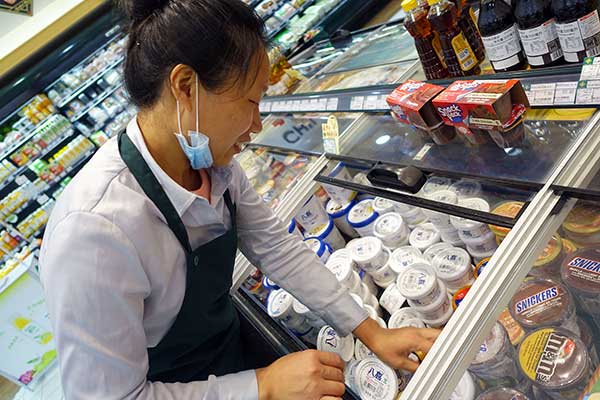Desserts reflect new lifestyle
By China Daily (China Daily)
Updated: 2016-07-06
 |
|
A worker puts boxes of ice cream in a refrigerator at a BHG supermarket in Beijing.[Photo by Wang Zhuangfei/China Daily] |
In recent weeks, the Beijing-based Baxi received attention for its low-fat coffee-flavored ice cream, while China Mengniu Dairy Company Ltd launched sugar-free Lueshasha under its "Mood for Green" line for diabetics. Many foreign brands followed suit to ensure their business thrived in China.
As disposable incomes of Chinese consumers rose in tune with expansion of retail infrastructure, China's ice cream market exploded in recent years.
But diabetes and obesity are becoming a huge problem of the Chinese society. According to the World Health Organization, "large increases" in the rate of obesity appear possible in China within ten years.
So, consumers are becoming picky with food products. To meet their demand for healthy foods, both local and foreign manufacturers have introduced low-fat or reduced-sugar products.
For instance, Unilever-owned Wall's has a special line called Paddle Pop. It is designed for health-conscious consumers. Made with real fruit juices, Paddle Pop Cyclone ice cream contains, per 100g, 98 kcal of energy, 20.2 g of sugar, and 0g of total fat.
That contrasts with Cornetto. Every 100g of Cornetto contains 311 kcal of energy, 23 g of sugar and 18 g of total fat.
In January 2014, Swiss giant Nestle released its policy on sugars, saturated fats and sodium, setting standards for various food components and additives. From last year, Nestle has added "Guideline Daily Amount" label to its packaging material to support the "Nutrition Table" on its back, to encourage consumers to choose healthier products.
"The Chinese market has a sophisticated dynamic and huge potential," said Honki Li, business executive manager of Nestle ice cream. "To succeed in this market, we must not only manufacture quality products that taste good but keep up with taste and lifestyle trends."
Ni Yuchen contributed to this story.

Inner Mongolian residents benefit from Ten Coverages project
In 2014, the Inner Mongolian government launched a project called "Ten Coverages", to enhance people's livelihood in the region.
